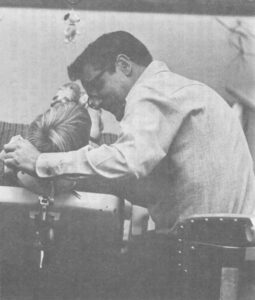(Note: The final speech at the National Conference on Behavioral Issues in Closed Institutions, held June 13-15 at Reston, Va., was delivered by Dr. Peter Steinfels, an associate for the humanities at the Institute of Society, Ethics, and the Life Sciences, Hastings-on-Hudson, N.Y. Steinfels, a young and vital scholar who works with the institute’s Behavior Control Research Group) won sustained applause with his brilliant development of the ethical issues presented by modern technologies of behavior change. Since the conference voted not to publish any of the speeches presented there, what follows is an attempt to excerpt and summarize his address. Of necessity, many subtleties of his argument are omitted. But even the bare bones of his analysis should be of great help to the layman who seeks guidance through this new and often very strange terrain).
“There is a tendency to criticize people doing ethical analyses for being absolutists, and then to demand from them hard and fast answers, sure-fire formulations, which can be mechanically applied in every situation,” says Dr. Peter Steinfels. “on the one hand, they are criticized for trying to impinge their views on the practitioners; on the other hand, they are dismissed for not supplying ready resolutions for the daily dilemmas met in applying and regulating our newly-discovered technologies.”
It may be a no-win situation, but Steinfels attempted to meet the demands both of theory and of practice as he addressed lawyers, behavioral scientists, policymakers, prison and mental hospital workers, and ex-prisoners and mental patients at the National Conference on Behavioral Issues in Closed Institutions June 15 at Reston, Va.
Steinfels’ speech on the ethical issues raised by behavior modification in closed institutions went well beyond the walls and straitjackets of institutions to examine basic issues of therapy and social control, goals and means, and freedom and coercion raised by new systems of behavior change.
Steinfels suggested three ways to think about the issues:
- By considering behavior modification as one element in the larger picture of “total institutions.”
- By considering behavior modification on four separate levels: individual, institutional, social-structural, and cultural.
- By considering behavior modification “through the lens of failure or success.”
Later, he proposed a fourth way: by considering behavior modification against a standard of human autonomy and self-awareness.
Steinfels noted that most discussion at the Reston conference had addressed the problems of doing anything useful in total institutions like prisons and mental hospitals. Questions about behavior modification procedures per se had almost been ignored, he said, implying “a rather striking vote of confidence for behavior modification once it is not tied to the institutional setting.”
But Steinfels had detected dissatisfaction at the conference when it came to lumping prisons and mental institutions together. “I have some doubts about whether this very powerful analysis of total institutions which has given us so many insights about the similarities of closed institutions” — not only prisons and mental hospitals but also institutions like submarines and nunneries — “hasn’t reached its limits,” he said.
Pushing further, Steinfels explored the multi-level approach.
- Individual. “It is on this level that most of the procedural problems are posed: preventive detention, coerced treatment, indeterminate sentences, involuntary commitment, right to treatment, inmates’ rights, and so on.”
- Institutional. The two main questions here, Steinfels said, are: “Are closed institutions or involuntary incarceration necessary at all? Are closed institutions and involuntary incarceration incompatible with any kind of planned change program?” Other questions at this level were: “What increase in danger should society tolerate in order to prevent instances of unjustified confinement? What are the advantages and disadvantages to the alternatives to incarceration, whether they be the ‘soft’ alternatives like community-based programs or the so-called ‘hard’ alternatives like technologies for individual control and surveillance?”
- Social-structural. Issues on this level include: “The causes of crime or mental illness; the power of professionals; the capacities society has, or lack of them, to care for the disabled; the funding of programs; poverty; sexism; racism; capitalism.”
- Cultural. “What is the relationship between our values and our attitudes toward deviance generally? What is the impact, for better or worse, of innovations in therapy on our image of the human?” Just as Freudian concepts have “seeped into the general ways of viewing the world that the culture has,” the same might be expected of behaviorist concepts of psychologists like B.F. Skinner.
Because favoring one level of approach can sometimes mean damage on other levels (“for example, a focus on the individual level prejudices the case at the institutional or social-structural level”), the theory of social change that underlies such favoritism must be spelled out, Steinfels warned.
Moving on to the success vs. failure approach, he said that its chief virtue is supposed to be that it sets ethical issues in the real world where “our conclusions will be effective.” But there’s a catch: a focus on the success of behavior modification techniques may well be guided by a fear “not that these new techniques will once again fail, but that they will succeed.”
“If psychosurgery or castration were no longer uncertain remedies with massive side effects but precise and effective procedures for controlling deviancy which could be kept carefully in the hands of qualified practitioners, then would not the issues of what behavior to control and who is to be the controller be posed in all their starkness?” Steinfels said. “And does not that prospect, of success rather than another failure, of either a Brave New World or Walden Two or a therapeutic utopia of any sort that we can imagine, depending on our proclivities — does not that prospect color the attitudes that we take toward these technologies in all their uncertain and underdeveloped form?”
II. The Politics of Therapy
“What is the difference between social control and therapy? What are the ethical limits on what we can do in the name of either?” These were the core questions in the second portion of Steinfels’ address.
The commonly accepted notion that social control and therapy must not be mixed is deceptive, he said. For one thing, “it is hard to imagine any kind of therapy which does not contain at least an element of social control, since notions of benefit are inevitably based on a socially established ideal.” And besides, “maintaining this distinction does not answer our questions on what are the limits on each.”
If you limit behavior therapy to situations where it benefits the individual, does that mean that society can never force therapy on a mentally disabled individual for his benefit as society defines it? Because behavior modification techniques are sometimes used in therapy, does that mean that the same techniques cannot be used for social control if they are not called “therapy?” These are some of the complexities Steinfels sketched.
The Western political tradition gives the state certain powers, he continued. With its mental commitment powers it can define its goal as “the restoration of the individual’s capacity to make further decisions about treatment for himself.” With its police powers it can define its goal as “the protection of society against certain acts.”
“But what means may it adopt to these ends?” Steinfels asked. “If costs are to be weighted against these benefits, what will account as a cost?”
Here he took up the standard proposed by lawyers to set the limit on the state’s use of behavior modification techniques: “the least restrictive, the least coercive, the least intrusive, the least onerous alternative.” The difficulty with the standard, he said, is that it tries to apply quantitative terms to changes in a person’s mind and behavior.
“Is toilet training to be considered a change of great, moderate, or minimal extent? How does it compare to learning to control violent impulses, or learning to avoid shoplifting…?” In other words, there are problems here of quality as well as quantity.
Steinfels illustrated the difficulties with the lawyers’ standard by applying it to the three things the state must consider in submitting an individual to behavior modification:
- The target change itself. The standard has almost no relevance here because authorities have already defined the desired change, and its measurable aspects (“whether it is extensive or enduring, novel or only a restoration”) are givens.
- The manner of change. Again, the choice of means “seems to depend on how much the change in question is already valued” by the authorities. Again, the measurable aspects (are the means rapid or drawn out? are they physical?) are hazy. “Is a procedure more or less ‘intrusive’ when it is rapid or drawn out? How significant is the physical intrusion aspect? The difference between implanting an idea in one’s skull and implanting an electrode is not satisfactorily explained on the grounds that the one is physical,” Steinfels said.
- The effectiveness of change. Is change reversible or resistible? Must the choice of an intrusive means depend on its effectiveness? Here Steinfels made an interesting case for ineffectiveness.
“Naturally we prefer that our physicians use antibiotics rather than sugar pills — that is, if they have the diagnostic capacities to know who should get the antibiotics. If they do not, and are given to medicating the wrong people at the wrong time, then we might prefer them to be limited to sugar pills.
“There are at least some grounds for believing that in the behavioral area techniques for altering behavior may outstrip our capacities for agreeing on the behavior to be altered and the behavior to be substituted. In the meantime, a little ineffectiveness might be a good thing — an admission of our state of ignorance.”
Steinfels concluded that the ethics of behavior change cannot be based on quantity, and that the criteria for the least restrictive, coercive, and intrusive alternatives “can only be elucidated in terms of an ideal which lurks behind them and which is a bit embarrassed to show its face.”
“That ideal,” he said, “is freedom.”
III. The Body and Mind of Freedom
Freedom as it is understood today is a poor guide for anything so demanding as law and social policy, Steinfels said. It is an idea so bent, pounded, nicked, and dulled by its everyday usage in the slogan pits of life that it hardly seems appropriate for this kind of analytic discussion.”
Moreover, the liberal idea of freedom handed down to us by Hobbes, Bentham, J.S. Mill, and more recent thinkers has serious defects. That defective idea of freedom originated, Steinfels said, with men fascinated by the Galilean science of physical mechanics. They defined freedom as “the absence of opposition, of impediments to motion.”
This led to physical imprisonment as the basic model for coercion — “walls, bars, chains, manacles, or at most the brute force which produces terror,” he said. In this model the person who was imprisoned was an “integral, indivisible body.” States of mind were imprisoned by walls and bars just as the body was. It was only the final inability of the body to move that mattered, he said.
“This definition makes freedom and coercion absolute opposites,” Steinfels observed, and it is at this point that the definition of freedom must now be revised to account for freedom beyond the body-freedom in the soul.
“I did not for a moment feel confined and the walls seemed like a great waste of stone and mortar,” wrote Henry David Thoreau of his experience in Concord Jail. Said Steinfels: “Is Thoreau’s remark nonsense and the man a fool? Who is this ‘I’ which did not feel confined even though the nontaxpayer H.D. Thoreau of Concord, Mass., was quite obviously in the town clink?
“On the other hand,” Steinfels continued, “consider the warning of R.D. Laing that ‘In the best places, where straitjackets are abolished, doors are unlocked, and leucotomies largely forgone, these can be replaced by more subtle leucotomies and tranquilizers that place the bars of Bedlam, the locked doors, inside the patient.'”
“What are we to make of this? Thoreau speaking of a free man in prison, Laing speaking of the prison within the apparently free man.”
The point to be drawn from the testimony not only of poets but of people locked up in the 20th Century, said Steinfels, is that “we cannot view men as individual atoms coerced by external forces, but as complex entities of subatomic components sometimes in conflict with one another.”
What makes people distinctly human, he said, is the capacity for self-consciousness “which allows us to take a stance toward our own behavior — to affirm it, to intend it as well as to do it, to act as well as to behave.”
This idea of freedom — of autonomy — “allows us to distinguish between different methods of control: between persuasion, imitation, influence, bribery, indoctrination, conditioning, transference, threat, psychotropic drugs, psychosurgery, ESB, and so on,” he said. “The measure would be the degree to which each contributed to, or short-circuited, the individual’s capacity for self-awareness or reflectiveness.”
Steinfels applied this measure to the key parts of the lawyers’ “least intrusive alternative” standard.
- As to the target change: Using the concept of autonomy “we see that the field of possible coercion is greatly enlarged. [But] on the other hand, coercion no longer stands diametrically opposed to freedom in every case. Where the overall reflectiveness of a person is the target which a procedure attempts to diminish, as indoctrination does and much advertising, and as operant conditioning could do, then we are rightly suspicious even though a procedure may involve no physical intrusiveness or pain.”
On the other hand, “when the same procedure, or even a painful, physically intrusive one, can clearly be estimated as affecting the person so that overall self-reflectiveness is increased, then it can rightly be welcomed as contributing to freedom.”
- As the manner of change: Here, “we would naturally prefer those techniques which would seem to involve great self-reflectiveness in the very procedure. The greater our uncertainty about whether the change itself is oriented toward increasing or decreasing self-reflectiveness, the more we are apt to insist that the procedure not transgress it.”
IV. What About Behavior Modification?
Assessing behavior modification as a specific technique, Steinfels saw both promise and peril. On the positive side, he listed these advantages:
-
- Behavior modification “does not ordinarily short-circuit whatever capacities for awareness and reflection, for approving or disapproving motivations, for identifying with or resisting one’s own behavior, which the subject possesses; at least it does not short-circuit them in the ways that psychosurgery, psychotropic drugs, and electronic stimulation of the brain do.”
-
- Behavior modification principles are easily understood and “the possibility of understanding and participating in, even helping design, one’s own modification, considerably enhances the potential of such procedures for increasing rather than decreasing autonomy.” Steinfels contended that “even where there is the risk of somewhat decreasing effectiveness, such an approach seems called for on ethical grounds.”
-
- Behavior modification “can undoubtedly restore aspects of human functioning which are undeniable conditions of any sort of autonomy. It can overcome massive obstacles to autonomy.”
On the negative side, he listed these drawbacks:
-
- Behavior modification “fits all too well into certain traditional patterns of abuse” in closed institutions, and also fits too well into “that pattern of regimentation which is partially a necessary ingredient in institutional maintenance and partially a reflection of institutional pathology.”
-
- The behaviorism of B.F. Skinner rejects the idea of mental states and of human autonomy. “As a methodological position this presents few problems to me,” he said, but as a metaphysical position “some of us think it is…naive and erroneous, some of us think it is politically disingenuous and dangerous, [and] some of us think it all of the above.”
Even if many behaviorists disagree with Skinner, “technologies do come trailing clouds of theory,” Steinfels warned, and until these dissident behaviorists “make unambiguous their determination to employ their methodology to support an autonomy which perhaps their methodology for the purpose at hand does not recognize, just as the physician must be willing to support a ‘health’ which cannot ultimately be defined by his science, or until behavior modification techniques are loosened from their metaphysics by a seepage into everyday life, then to a large extent practice will be held hostage to theory.”
Skinnerians who can’t be shaken by any argument should at least heed their mentor’s own urging that prisoners and mental patients be taught behavior modification techniques to be used for “counter-control,” he said, “for in the end the practical task of the ethics of what we do to the powerless will always remain what we do to the powerful.”
Received in New York July 7, 1975
©1975 Ron McCrea
Ron McCrea is an Alicia Patterson Foundation award winner on leave from The Capital Times (Madison, Wisconsin). This article may be Published with credit to Mr. McCrea, The Capital Times, and the Alicia Patterson Foundation.





